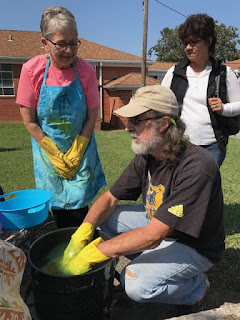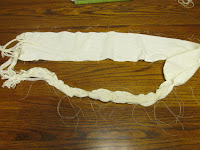To complete a woven shibori guild project all participants will be dyeing their warps at our meeting this coming Saturday. I'm supplying the dyepot and said that I'd make up a fresh one - the guild is paying for materials.
As it turns out I still had the dyepot from our guild dye day last year and decided to try to bring it back to life to see if that could be done. The dyepot has been sitting covered out in the back shed the whole time.
I followed recommendations in adding small amounts of a) the pre-reduced indigo, b) thiox, and c) soda ash. In each case stirring gently and then leaving for 15 minutes. I then waited for a further 30 minutes to see what if any reaction there was. For the first go around - none!! I repeated the process and once again waited and noted that now the dyepot was returning to the expected green color so decided to try dyeing some pre-soaked cotton.
Two dips of 5 minutes each with 15 minutes after each dip to oxidize and I had a pretty reasonable blue. I then repeated the process with the woven shibori warp which had been soaking in water overnight.
After the last 15 minute oxidize I hosed off the warp then brought it inside and washed it first in Dharma professional textile detergent in tepid water, then two rinses, by which time there was little if any blue residue.
After unpicking the pull stitches from the woven shibori scarf I was able to lay the cloth out flat to dry.
 |
| Woven shibori scarf after drying (camera flash lightens the blue) |
 |
| Reasonable dark blue (no flash) |
Overnight the dyepot developed a pretty reasonable bloom.
 |
| Bloom on the indigo dye |
Given that this was a re-awakened dyepot and not a full strength version (good for 2 lbs of material) I decided 10 oz of Clun Forest handspun yarn with one dip should work OK and use up a lot of the indigo before I dispose of it ready for the new dyepot this weekend.
 |
| 5 skeins of indigo dyed Clun Forest handspun yarn. |
It will be interesting to see how the refreshing of this next dyepot goes as we will be dyeing between 1.5 and 2 lbs of cotton this time. At least I know it is possible to wake it up again.






















